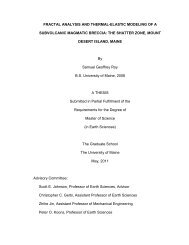Latis II Underwater Remotely Operated Vehicle Technical Report
Latis II Underwater Remotely Operated Vehicle Technical Report
Latis II Underwater Remotely Operated Vehicle Technical Report
You also want an ePaper? Increase the reach of your titles
YUMPU automatically turns print PDFs into web optimized ePapers that Google loves.
ABSTRACT<br />
For the first time, a University of Maine<br />
Mechanical Engineering Senior Capstone Design<br />
group designed and built an underwater<br />
remotely operated vehicle (ROV) and will<br />
participate in the 2010 MATE International ROV<br />
Competition. Four senior Mechanical<br />
Engineering design students have worked on<br />
preparing a prototype underwater ROV (<strong>Latis</strong> I)<br />
and their final underwater ROV (<strong>Latis</strong> <strong>II</strong>) for the<br />
competition. Missions included such tasks as<br />
sensing and measuring sound waves, accurately<br />
measuring fluid temperature, navigating<br />
through an underwater cave and collecting<br />
crustaceans and other materials from<br />
underwater and returning them to the surface.<br />
While <strong>Latis</strong> I provided much needed practice<br />
and valuable insight into designing an<br />
underwater ROV, <strong>Latis</strong> <strong>II</strong> was designed to<br />
complete the missions outlined by MATE for the<br />
competition. The UMaine ROV Team built two<br />
identical four-degree-of-freedom (DOF) arms<br />
with open-and-close grippers. To manipulate<br />
the arms on the ROV the team also built two<br />
control arms which provide feed-forward<br />
control. <strong>Latis</strong> <strong>II</strong> has a custom-made upper body<br />
structure machined from High Molecular<br />
Weight Polyethylene (HMWPE) and a stainless<br />
steel lower frame. There are six static thrusters<br />
providing six DOF control, three cameras and a<br />
holding net. Onboard control is achieved using a<br />
Compact Rio (C-Rio) which receives signals from<br />
a space navigator joystick and an Arduino<br />
2<br />
LATIS <strong>II</strong><br />
TECHNICAL REPORT<br />
micro-controller that translates information<br />
from the control arms.<br />
TABLE OF CONTENTS<br />
Abstract ....................................................... 2<br />
Budget/ Expense ......................................... 3<br />
ROV Electronics ........................................... 4<br />
Main Controller ....................................... 4<br />
Thrusters ................................................. 4<br />
Servos ...................................................... 4<br />
Sensors .................................................... 4<br />
Custom Circuit Boards ............................. 4<br />
Surface Controls .......................................... 6<br />
Main Controls .......................................... 6<br />
Arm Controls ........................................... 6<br />
Power Supply Box ................................ 6<br />
Software ...................................................... 7<br />
Design Rationale ....................................... 11<br />
Missions ................................................. 11<br />
TASK #1 – Resurrect HUGO................ 11<br />
TASK #2 – Collecting Crustaceans ...... 11<br />
TASK #3 –Sample New Vent Site ....... 12<br />
TASK #4 – AGAR Sample .................... 12<br />
ROV Design ........................................... 12<br />
Frame..................................................... 12<br />
Arms ...................................................... 13<br />
Tether .................................................... 14<br />
Thrusters ............................................... 14<br />
Cameras ................................................. 14<br />
Challenges ................................................. 15<br />
Troubleshooting Techniques .................... 15<br />
Lesson Learn/ Skills Gained ....................... 16<br />
Future Improvements ............................... 17<br />
Loihi Seamount ......................................... 18<br />
Reflections................................................. 19<br />
References ................................................ 20<br />
Acknowledgements ................................... 20

















